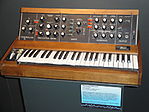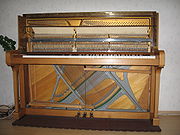- Polyphony (instrument)
-
Polyphony is a property of musical instruments, meaning they can play multiple notes simultaneously. Instruments featuring polyphony are said to be polyphonic.[citation needed] Instruments that are not capable of polyphony are monophonic.
Contents
Synthesizer
Most of early synthesizers were monophonic musical instruments which can play only one note at a time, and are often called monosynth as opposed to polysynth. For example, Minimoog has three oscillators which are settable in arbitrary intervals, but it can play only one note at a time (with a timbre consists of three pitches of fixed-intervals).
Duophonic synthesizer
Duophonic synthesizers, such as the ARP Odyssey and Formanta Polivoks built in the 1970s, has a capability to play independent two pitches at a time. These synthesizers have (at least) two oscillators separately controllable, and duophonic keyboard that can generate two control voltage signals for lowest- and highest-note. When two or more keys are pressed simultaneously, lowest- and highest-note will be heard. When only one key is pressed, both oscillators are assigned to one note, and possibly more complex sound will be heard.
Polyphonic synthesizers
The earliest polyphonic synthesizers were built in the late 1930s, but the concept did not become popular until the mid 1970s. Harald Bode's “Warbo Formant Orguel”, developed in 1937, was an archetype of a voice allocation polyphonic synthesizer.[1] Novachord by Hammond Organ Company, released in 1939, is a forefather product of octave divider synthesizer and electronic organs. It uses frequency divider technology to generate polyphony,[2] and about one thousand Novachords were manufactured until 1942.[3]
In the early 1970s, Allen Organ Company, E-mu Systems and Yamaha independently developed digital keyboard scanning technology, and the results were known as Oberheim 2/4/8-voices licensed by E-mu Systems [4] and Yamaha GX-1.
Synths using octave divider
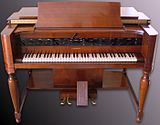


Hammond Novachord (1939)
A forefather of octave divider synth and electronic organs.Moog Polymoog (1975)
Octave divider technology similar to Novachord was used.Korg PE-1000 (1976)
Polyphonic ensemble keyboard consists with one synth per key (totally 60 synthesizers).Korg PS-3300 (1977)
Although it uses octave divider, it contains three synths per key.Synths using voice allocation
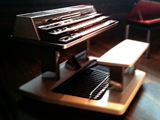
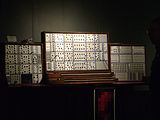


Yamaha GX1 (1973)
Voice allocation technology was used to assign limited 8-voices per manual into notes.E-mu Modular System (1972)
In 1974, E-mu released polyphonic keyboards for it.[4]Oberheim 4voice (1975)
Polyphonic technology was licensed by E-mu Systems.[4]Sequential Circuites Prophet-5 (1977) is one of the most popular polyphonic synth featuring patch memories, also used E-mu's technology.[4] Number of voices
One notable early polyphonic synthesizer was the Sequential Circuits Prophet 5, which was released in 1977 and had five-voice polyphony. Six-voice polyphony was standard by the middle 1980s. With the advent of digital synthesizers, 16-voice polyphony became standard by the late 1980s. 64-voice polyphony was common by the middle 1990s and 128-note polyphony arrived shortly after. There are several reasons for providing such large numbers of simultaneous notes:
- Even with only ten fingers, it is possible to play more than ten notes at once. Notes may continue to sound even after a key is released. The synthesizer's resources may still be in use to produce the sound of the previously struck notes tapering off, especially when a sustain pedal is used.
- A "sound" (also called a "timbre" or "patch") may be generated by more than one oscillator or sound-source to allow more complicated sounds to be produced. A synthesizer with 16 oscillators may be capable of 16-note polyphony only when simple, single-oscillator sounds are produced. If a particular patch requires four oscillators, then the synthesizer is only capable of four-note polyphony.
- Synthesizers may be configured to produce multiple timbres (multitimbral), particularly necessary when sounds are layered or sequenced. Multitimbral instruments are always polyphonic but polyphonic instruments are not necessarily multitimbral. Some multitimbral instruments have a feature which allows the user to specify the amount of polyphony reserved or allowed for each timbre.
Note priority of synthesizer
Synthesizers generally use oscillators to generate the electric signal that forms the basis of the sound, often with a keyboard to trigger the oscillators. However multiple oscillators working independently are a considerable challenge to implement. To double the polyphony, not only must the number of oscillators be doubled but the electronics must also function as a switch connecting keys to free oscillators instantaneously, implementing an algorithm that decides which notes are turned off if the maximum number of notes is already sounding when an additional key is pressed. There are several ways to implement this:
- Turn off the first note sounded and use the newly freed oscillator to play the new note. With last note priority, priority is based on the order in which keys are played. When new notes are triggered while all voices are playing, the synthesizer frees up polyphony by ending the earliest played sounding note. This is the default mode on most synthesizers.
- Turn off the last note sounded and use the newly freed oscillator to play the new note
- Ignore the newly depressed note. With first note priority, earlier notes are not cut off to make room for later ones, and once maximum polyphony has been reached, the person playing the instrument must stop playing one or more notes in order to trigger new ones.
- In highest note priority, new notes that are higher in pitch than ones being already played replace currently playing notes from the lowest on up.
- Lowest note priority works in the same way, but cutting notes from the highest down.
Modern synthesizers and samplers may use additional, multiple and/or user-configurable criteria to decide which notes sound.
Keyboard instruments
Acoustic keyboard instruments
Almost all classical keyboard instruments are polyphonic. Examples include the piano, harpsichord, organ and clavichord. These instruments feature a complete sound-generating mechanism for each key in the keybed (e.g., a piano has a string and hammer for every key, and an organ has at least one pipe for each key.) When any key is pressed, the note corresponding to that key will be heard as the mechamism is activated.
Some clavichords do not have a string for each key. Instead, they will have a single string which will be fretted by several different keys. Out of the keys that share a single string, only one may sound at a time.
Electric keyboard instruments
The electric piano and clavinet rely on the same principles to achieve polyphonic operation. An electric piano has a separate hammer, vibrating metal tine and electrical pickup for each key.
With a few exceptions, electric organs consist of two parts: an audio-generating system and a mixing system. The audio-generating system may be electronic (consisting of oscillators and octave dividers) or it may be electromechanical (consisting of tonewheels and pickups), and it sends a large number of audio outputs to a mixer. The stops or drawbars on the organ modify the signal sent from the audio-generating system, and the keyboard switches the mixer's channels on and off. Those channels which are switched on are heard as notes corresponding to the depressed keys.
Stringed instruments
Classical instruments
Stringed instruments may be polyphonic if they have a separate string for each note to be played. The harp has a large number of strings, one for each note in the scale, so it is polyphonic; The guitar has multiple strings and is usually chorded and not played one string at a time, so it is polyphonic; The violin has multiple strings, but usually only one is bowed at a time, so the violin family of instruments are considered to be monophonic.
Some eastern instruments include strings which are fretted and plucked like those on a guitar, plus secondary strings which resonate and provide reverberation on a few key notes. This is technically not polyphony, but it can be used to simulate polyphony.
Newer instruments
The electric guitar, just like the classical guitar, is polyphonic, as are the various guitar derivatives that have turned up (including the harpejji and the Chapman stick).
Woodwinds and brass
Although polyphonic wind instruments are relatively rare, they do exist. Multichambered ocarinas are manufactured in a number of varieties, including double, triple, and quadruple ocarinas, which use multiple chambers to extend the ocarina's otherwise limited range, but also enable the musician to play more than one note simultaneously. Harmonic ocarinas are specifically designed for polyphony, and in these instruments the range of the chambers usually overlap to some extent. Cross-fingering enables a single chamber to span an entire octave or more.
Recorders can also be doubled for polyphony. There are two types of double recorder; the drone type and the polyphonic type. In the drone type, one tube is tuned exactly like a regular recorder with a range of approximately two octaves, and the other tube is a drone and plays the tonic note of the scale. The polyphonic recorder has two tubes with a range of one major sixth. With overblowing, some notes can be played an octave higher, but it is not possible to achieve the range of an entire octave in one tube with these instruments.
See also
- Monophonic (synthesizers)
- Duophonic
- Paraphony
References
- ^ Tom Rhea (2004). "Harald Bode biography". New York: Experimental Television Center Ltd. Archived from the original on 2011-07-19. http://web.archive.org/web/20110719162439/http://www.experimentaltvcenter.org/history/people/bio.php3?id=83. (also broken format page is remained here)
- ^ "Novachord Schematics". novachord.com. http://www.novachord.com/schematics.html.
- ^ "Introduction to the Hammond Novachord". novachord.com. http://www.novachord.com/intro.html.
- ^ a b c d "The History Of Emu Systems". 30 Years of Gears. MIT Media Lab. https://www.media.mit.edu/resenv/classes/MAS963/history/emu.html.
Categories:- Synthesizers
Wikimedia Foundation. 2010.

